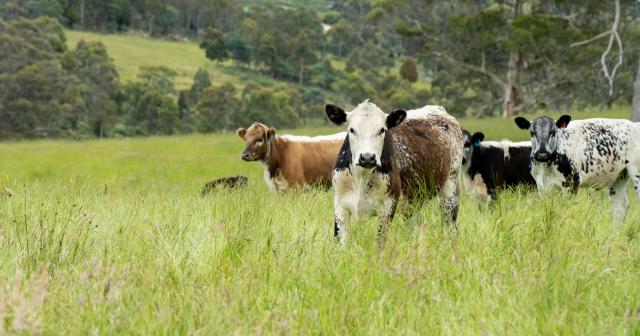Massey University has begun trialing the use of superior beef genetics in its two dairy farms as part of Beef + Lamb New Zealand’s Dairy Beef Progeny Test.

Hamish Doohan, Massey University’s Farm Operations and Sustainability Manager, says as one of the new hosts of the Dairy Beef Progeny Test (DBPT), Massey University will be looking to further minimise the number of bobby calves born every year and add value to its non-replacement calves by finishing them within their wider farm operation.
The University’s two dairy farms, which also host numerous research projects, are run under two very different systems.
Dairy One is a 119ha dairy unit running 260 cows on a once-a-day milking system. The herd is made up of one-third Jersey, one-third crossbred and one-third Friesian-based cows.
Soils on Dairy One, which lies adjacent to Palmerston North and the Manawatu River, are free-draining and the farm hosts the Whenua Haumanu programme; a partnership between Massey University and the Ministry for Primary Industries that carries out comprehensive research into regenerative agriculture.
Dairy One is a DairyNZ system one/two farm, so there is no imported feed. The cows are wintered on the dairy platform.
Dairy Four is the opposite. It is a more intensive dairy operation running 600 Friesian-based cows on a traditional twice-a-day milking regime.
The unit, which covers 220ha effective, has heavy clay soils and is a system four farm, so imported supplementary feed is used. A proportion of the herd is wintered on Massey University’s Keeble Farm and the balance is wintered in a free-stall barn.
Hamish says they have been using beef genetics to try and add value to their non-replacement calves for eight years.
In Dairy One, they had been using Hereford and Wagyu genetics and Hereford genetics in Dairy Four. Four years ago, they added Charolais genetics to the mix and were very impressed with the results.
There was no noticeable increase in calving problems and Charolais cross cattle grew-out well, with the majority sold prime before their second winter.
Both the Charolais and Hereford genetics the Massey University farms had been using had already proven their worth as “graduates” of the Dairy beef Progeny Test and their progeny performed to expectations. This reinforced the value of using genetically superior beef bulls in their mating programme.
Hamish says by signing up to host the DBPT, Massey University will get access to the bulls selected for the Progeny Test earlier and will be helping the wider industry by identifying the genetics that best add value to non-replacement dairy calves.
“It will help farmers identify what genetics they may want to use in the future.”
Striving to minimise the number of non-replacement calves sent to slaughter, the University will be taking advantage of tools such as sexed semen as well as beef genetics to produce an animal for a different value chain.
Last spring’s mating was Massey University’s first as DBPT hosts and on the Dairy Four farm, 10 different sires, a mix of Hereford, Angus, Charolais and Simmental bulls, were used in the Artificial Insemination (AI) programme.
One Dairy One, six different sires, two Angus, two Hereford and two Charolais, were used.
Angus bulls with low birthweight Estimated Breeding Values (EBVs) were used across the Jersey cows to help reduce the risk of calving problems and the bulls selected for use across the smaller crossbred cows also had EBVs for birthweight that were at the lower end of the range.
As host farms, staff on the dairy farms will be required to record mating dates, pregnancy diagnosis, calving dates and calf weights.
The calves will be reared in cohorts and a record kept of how they were reared and the weights and date of weaning.
After weaning, the calves will be sent to Massey University’s drystock farm ‘’Keebles’’, one of the three blocks that make up the University’s Sheep, Beef and Cattle Research Unit, and grown out on grass. To ensure a fair comparison of the genetics, the cattle will be run in mobs which represent the sires used.
Their 200,400 and 600-day weights will be recorded and B+LNZ will organise a contractor to eye-muscle scan the cattle prior to slaughter. Massey University will then need to submit slaughter data.
Hamish says the aim is to get all beef cross animals sold as prime before their second winter, but usually a few are carried through for finishing in spring.
“We have the luxury of multiple soil types so we can winter animals on lighter, free-draining soils.”
The Massey University farms are part of phase three of B+LNZ’s DBPT which involves more farms and a new approach to identifying opportunities offered by superior dairy beef.
The DBPT had been based on Limestone Downs then Pāmu‘s Renown farm but last spring, cows on five new host farms across three regions were mated to DBPT sires representing Angus, Hereford, Charolais, Simmental and Murray Grey breeds.
While the locations have changed, the objectives of Dairy Beef Progeny Test (DBPT) remain the same; these are to identify the best beef genetics and to highlight the value superior beef genetics generate at every stage of the supply chain.
As well as the two Massey University farms, new host farms are two Dairy Trust Taranaki farms and an owner-operated commercial dairy farm at Five Forks near Oamaru. For the first time, Jersey cows will be included in the DBPT.
Jim Inglis, Beef + Lamb New Zealand Strategy and Operations Manager, says the move to run the DBPT across more sites was driven by a desire to include a wider cross-section of farms across more regions and therefore better showcase the outcomes of the DBPT.